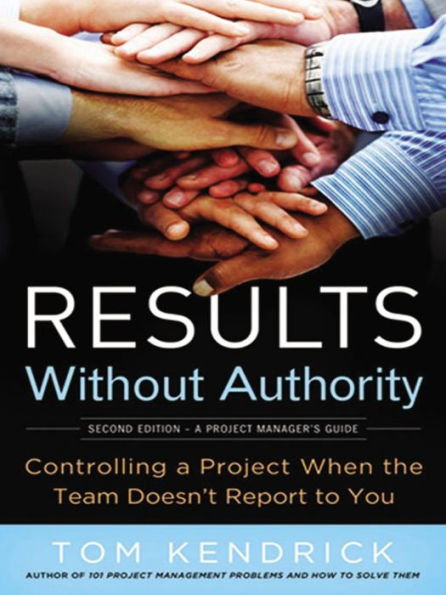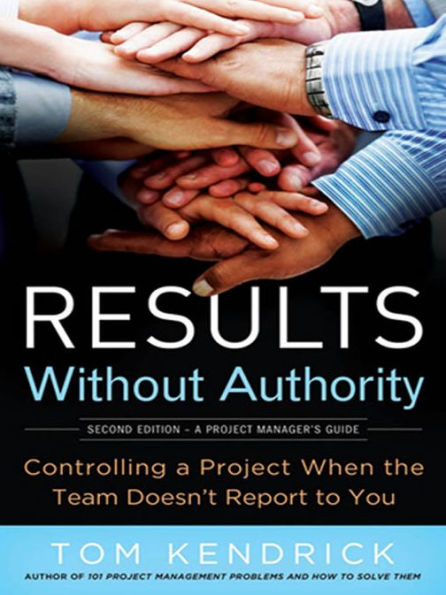Read an Excerpt
RESULTS WITHOUT AUTHORITY
Controlling a Project When the Team Doesn't Report to You
By TOM KENDRICK
AMACOM
Copyright © 2012 Tom Kendrick
All right reserved.
ISBN: 978-0-8144-1782-9
Chapter One
Control of Projects
Projects are everywhere. Some of these projects succeed; others do not. Many projects fail because the project leader lacks sufficient control to keep things moving toward a successful conclusion. Insufficient project control is a result of many factors: lack of authority, geographically distributed teams, excessive project change, competing priorities, and inadequate planning—just to name a few.
Increasingly today, projects are undertaken in environments where the project leader has little formal authority. Even for project managers with formal authority, significant portions of project work are done by contributors who work for other managers, often for a different company. Projects where no one is in charge are almost certain to fail. As the leader of your project, you must assume control, whether or not you possess organizational authority. As unlikely as it may sometimes seem, any project leader can do much to establish and maintain project control. This book has many ideas for achieving project success using techniques that don't depend on organizational position or on formal authority.
* Who's in Charge?
In classes, workshops, and informal discussions of project management that I've been a part of, one of the most common questions is, "How can I manage my project if I have no power or authority?" This issue comes up so often that I developed a list of things that project leaders can (and should) take control of, regardless of their position or power in an organization. None of these things requires any authority beyond what is implicit when you are delegated responsibility for a project, and some don't even rely on that.
Factors That Any Project Leader Can Control
• Measurement
• Reporting cycles
• Milestones
• Communication
• Project reviews
• Change management
• Rewards and recognition
• Constructive criticism
• Reciprocity and exchange
• Risk monitoring
Project leaders can use these means, along with many others in this book, to enhance their control in any project environment. Because the techniques outlined in the next several chapters don't rely on the command-and-control authority of the project leader, they are effective in cross-functional, agile, matrix, heavily outsourced, virtual, volunteer, and other challenging environments. In fact, even project managers with substantial authority will benefit from the practices described in this book because they avoid the potential resentment and demotivation that can result from pulling rank.
* Structure of This Book
The first half of this book explores three elements of project control: process, influence, and measurement. This introductory chapter introduces these elements, and Chapters 2–4 dig into the details and show how to apply them in your project environment.
The second half of the book examines when to use these three elements for control throughout the life of a typical project. The Guide to the Project Management Body of Knowledge (PMBOK® Guide), from the Project Management Institute, identifies five process groups: initiating, planning, executing, monitoring and controlling, and closing. Chapters 5–9 map these topics, describing how to better control your project from its beginning to its end. Where the PMBOK Guide tends to assume that a project manager has formal power, the discussion throughout this book focuses on controlling project work even when you do not have such direct authority.
Each chapter begins by outlining the principal concepts for that chapter, then explores each idea in detail using examples. Each of Chapters 2–9 concludes with a summary of key ideas, and Chapter 10 summarizes the fundamental ideas of the book and offers some final thoughts on applying them to your projects.
This book contains many ideas—far more than any single project would ever need. The advice ranges from tips useful on small projects to ideas for dealing with the complexity of large, multiteam programs. Read through the book using your own judgment to determine which ideas are the most effective and helpful for your specific situation. To get started, pick an idea or two from each section that you think will help you with your project. When you encounter a problem, use the table of contents to locate pointers to deal with it, and adapt the practices outlined there to move things back under control. Don't overcomplicate your project with processes that aren't needed; if two approaches to a project issue are equally effective, always choose the simpler one.
* Elements of Project Control
Every project leader has a number of levers available that increase project control. Three principal elements of control are:
1. Project processes
2. Influence
3. Metrics (measurement)
Project processes provide the structure necessary for control and can serve as an effective substitute for organizational authority. You can build influence in many ways, and the more you are able to sway, encourage, or win over those you are working with, the better you will be able to control your project. Measurement quantifies results and drives behavior, so metrics are useful for both understanding the status of your project and encouraging cooperation. With these three techniques, you can control and be successful with any type of project.
Project Processes
Some years ago, a good friend celebrated a fiftieth birthday at a bowling alley with about a hundred friends. (Names are withheld to shield the guilty.) Because most of us in attendance were of roughly the same age and few had bowled more than once in the previous three decades, the initial frames we bowled were spectacularly pathetic. In the intervening years, the gutters on either side of the lanes seemed to have developed an almost magnetic attraction for bowling balls. Some people were halfway through their initial game and still trying to knock down their first pin.
Fortunately, the alleys had bumpers on either side, which we soon flipped into position on almost all of our lanes. These bumpers ran the length of the lane over the gutters, so balls that would have otherwise fallen out of play were bounced back onto the lane. With more balls rolling toward the pins (if not exactly in the center of the alleys), scores improved dramatically.
Good processes for projects are analogous to bumpers in bowling. Well-defined processes, properly applied, keep projects from rolling off into the gutter. Project processes are a source of substantial control, and they are usually owned by project leaders because much of the work is their personal responsibility.
Early in a new project, a project leader can easily influence even project processes that others own as they are being established. Most people can recall the unpleasant results caused on projects that lacked sufficiently defined processes. Your team members, stakeholders, managers, and sponsors are all likely to agree to process discipline that addresses past problems and inefficiencies. When initiating your overall project infrastructure, work to define all processes affecting your project team, and to get them accepted by everyone in advance.
Processes permeate the project life cycle. Some are related to specific phases of project work, such as those for requirements definition, scope freeze, baseline planning, risk identification, and project review. Other processes apply throughout a project, such as those for communication and change management. Whatever their timing, clearly defined processes are bumpers that enable the project leader to keep the ball rolling toward the final objective. Project processes are the main topic of Chapter 2.
Influence
In projects, as in most situations, people tend to work on the things that they want to work on. Even when a leader's authority is absolute, ordering people to do something doesn't make them want to do it. Using command-and-control authority to force people to do things unwillingly leads to resentment and demotivation. Malicious compliance is also a risk; people may find ways to appear to cooperate while actually harming the project. In extreme cases, some people will fail to do as they are asked even when the personal consequences of noncompliance are severe. If generals and admirals cannot always expect automatic obedience, what chance does a project leader have?
Nevertheless, as project leader, you have a fairly good chance of gaining support if you use the correct approach. Getting cooperation is much easier when you have a two-way relationship of trust and respect with your team members. Effective project leaders create this essential foundation for influence through team-building activities, formal group events (such as project start-up workshops), and informal one-on-one interactions. The surest path to cooperation starts with establishing strong social relationships in which people don't want to disappoint each other.
Another way to enlist willing cooperation is to involve your project staff in activities that they want to work on. When a team member is enthusiastic about the project work, there's no trick to it; the project leader has little more to do than assign ownership and stay out of the way. When project work does not appeal to the members of your project team, however, you must work to create interest in it. The principal technique begins with an understanding that everyone's favorite call letters are WIIFM: What's in it for me? Leaders in any field invest the time to understand what the people they are working with really care about. Effective project leaders identify opportunities to align the project's needs with what the individuals want to do, and they assign responsibility for project activities accordingly. The tools of influence rely on reciprocity—an exchange of something that the individual wants for the commitment to complete work that the project requires.
Another key to influence is effective communication. Either project leaders are good communicators, or they are not project leaders for long. Communication is the one absolutely undisputed responsibility owned by the project leader, regardless of project type, other responsibilities, or authority. To succeed and retain control, you must manage information and always communicate effectively.
Formal project communication includes written documentation for your project, such as plans and progress reports. Using the power of your pen, you can control your project through filtering and summarizing and by deciding how best to distribute information and when.
Informal communication is also an essential component of project control. Influence and relationship building depend on frequent conversations and other casual interactions. Often you will learn about project problems much earlier through informal discussions than from formally collected project status. The earlier you can detect problems, the more options you have. Control depends on the quick resolution of issues and problems. You can also influence others by asking revealing (and sometimes embarrassing) questions. When your authority is insufficient to avoid situations that could harm your project, asking a pointed question or two at the right time can have the same effect. Your perspective as the project leader—understanding the work, the capacities of your team, and the project's priorities—enables you to guide people to rational conclusions that are consistent with project success.
Establishing and using influence for project control is explored in detail in Chapter 3.
Metrics
Control in any environment relies on measurements. Without clearly defined limits, the very concept of control lacks meaning. In addition to the obvious role of metrics in determining overall project performance, metrics also affect the behavior of the project team. As Bill Hewlett, founder of the Hewlett-Packard Company, is reputed to have said, "What gets measured gets done." Measuring a few key things on a project and publishing the results powerfully affect your project's progress.
A small set of well-defined project metrics gives the project leader a powerful tool for managing project initiation, execution, and closure. Effectively using project measurement for project control is the topic of Chapter 4.
* No One Ever Said That Projects Are Easy
One analogy I like to use is that running a project is like driving a vehicle down a steep hill. Control of a moving vehicle involves the use of the steering wheel, the accelerator, and the brake. Having all three is nice. With projects, however, someone else's foot is on the accelerator, and, if you brake, you will be late. You do have both hands on the steering wheel, though. So you steer with process, influence, and metrics, keeping your trajectory as true as you can. With adequate preparation, diligence, and attention to detail, you can reach your destination, exhausted but exhilarated, with no casualties and only a few scratches, dings, and minor dents here and there. Project control starts at project initiation, and it requires your full attention all the way to the end. Applying the concepts you find in this book will carry you safely to your destination: project success.
Chapter Two
Control Through Process
Most modern projects are difficult. Lacking effective project management processes, most projects fall into certain chaos. Projects undertaken using practical methods have a much better chance of success, especially when the project leader has little formal authority.
The foundation of effective project management has been established for a very long time. Proposing—and gaining support for—clearly defined project processes that make sense in your environment can significantly improve control over your projects. Adopting proven project practices with your team provides structure and guidance that provides you with additional levers to use in influencing your team. When you lack (or prefer not to rely on) formal authority, employing good processes that your contributors understand and use can keep your project moving in the right direction.
This chapter outlines important processes that can be used to improve your ability to keep a project under control. We also explore the benefits of a well-defined project infrastructure and how to take advantage of a structured project office.
* Project Management Processes
Successfully managing a project involves at least three separate activities: achieving project objectives, managing the project processes, and leading the team. The overall objective, the most visible of the three, depends heavily on processes and leadership. The best project leaders spend much, if not most, of their time interacting with people, and productive team leadership is the main topic of Chapter 3. The focus of this chapter is on managing processes. Project leaders who collaboratively fine-tune the project processes used by their teams gain control in two ways. Using processes that project contributors and stakeholders participate in defining augments the trust and collaborative environment that successful projects depend on. In addition, getting voluntary commitment to use well-defined processes encourages appropriate behavior; it's a lot more straightforward to lead a project by helping people follow agreed-on processes than by ordering your team to do things because you say so.
Some project processes are built in; that is, your organization does things in a certain way, and you and your project team have little choice but to conform. Even when the principal processes are mandated in advance, however, some processes belong solely to the project leader, and still other project processes involving your team and project stakeholders are at least partially yours to influence and control. Gaining the necessary buy-in and commitment needed to adopt new project processes or to improve existing processes may require some effort on your part. The effort is easily justified in most cases, though, especially when defining processes that can make the difference between a project you are able to keep on track and one that tumbles into chaos. Some project processes that can help are:
• Life cycles and methodologies
• Project definition and charter
• Project planning, execution, and tracking
• Change management
• Information management
• Project management software tools
• Contract and procurement management
• Risk management
• Quality management
• Issue management
• Decision making
(Continues...)
Excerpted from RESULTS WITHOUT AUTHORITY by TOM KENDRICK Copyright © 2012 by Tom Kendrick. Excerpted by permission of AMACOM. All rights reserved. No part of this excerpt may be reproduced or reprinted without permission in writing from the publisher.
Excerpts are provided by Dial-A-Book Inc. solely for the personal use of visitors to this web site.






